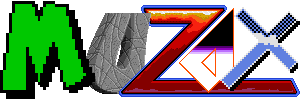 In the third and final part of Muzax, dedicated to Chris Huelsbeck, you will hear music from the games "The adventures of Quik and Silva", "Apidya", "Jim Power: In Mutant Planet" and "Turrican 3" as they appear on Amiga, Atari ST, Super Nintendo and on audio CD.
In the third and final part of Muzax, dedicated to Chris Huelsbeck, you will hear music from the games "The adventures of Quik and Silva", "Apidya", "Jim Power: In Mutant Planet" and "Turrican 3" as they appear on Amiga, Atari ST, Super Nintendo and on audio CD.Listen to this podcast : (comments in French)
Download this podcast in MP3 format by clicking on this link. (comments in French)
Content of broadcast:
Welcome to Muzax, the video games music broadcast.
Let's continue to discover music composed by Chris Huelbeck.
Highly appreciated in the 80s and the 90s, digitalized voices show off the skills of the developer/musician and produce amazing sound effects.
The intro of "The adventures of Quik and Silva" on Amiga is an excellent illustration of the use of digitalized voices.
We are now listening to the music you hear during the game.
The first CD of Chris Huelsbeck, called "Shades", was published by "synSONIQ" in 1991. It is a best-of of his most famous hits including R-type, Turrican and Shades, of course.
Apidya, a very well-designed production, is released in 1992. It is also a shoot 'em up game and unexpectedly the player doesn't pilot a spaceship but a bumblebee.
The music of this game was played by a symphony orchestra during the « Symphonic Game Music Concert ».
This event has been taking place several times a year since 2003 in Leipzig, Germany.
Let's go right to the heart of the game.
Let's go to level 4 with a completely different style of music.
We can easily identify the 90s music style.
« Jim Power: In Mutant Planet » is published by « Loriciels », one of the most dynamic French companies in creating and publishing video games in the 80s and the 90s.
At that time, Loriciels published famous personal-computer games. But unfortunately, just after Jim Power release, the company went into liquidation because of a large outstanding payment from its American distributor.
Now listen to the Atari ST version.
The style is different but the adaptation remains faithful to the original version.
Chris also made console versions for PC-Engine, Super Nintendo, Sega Megadrive and PC
The third episode of Turrican is called "Super Turrican" on Super Nintendo and "Mega Turrican" on Megadrive. Fans put pressure on them to produce a version for Amega. It was released under the name "Turrican 3".
When the golden age of 16-bit computers such as Amiga and Atari ST had passed, video game companies decided to release their new games on the latest generations of consoles and PCs.
Let's go to the first level of Turrican on Super Nintendo.
Of course Chris follows this evolution and composes music for games published on these new machines.
He also composed film and show music and brought out several audio CDs of his most famous hits.
Listen to the music from the end of Turrican 3 on the CD version.
Since the age of 17, Chris has composed the music for over 70 games.
In 1998, he left Germany and followed the company Factor 5 to California where he composed several pieces of game music for them, including those for the Star Wars series.
This broadcast dedicated to Chris Huelsbeck is now over. Thanks for listening and tune in soon for a new episode of Muzax.










